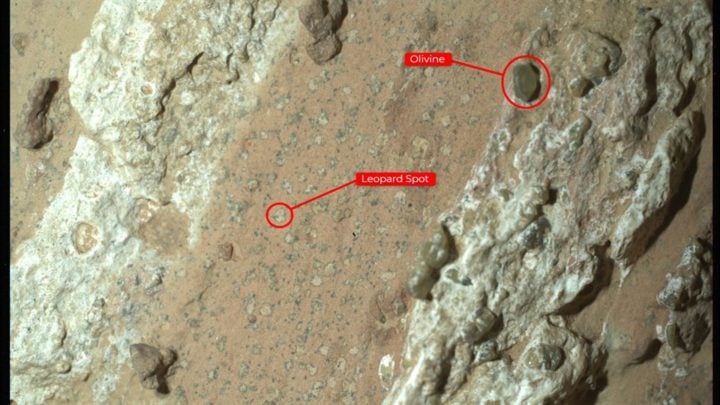The Perseverance Mars rover has found an intriguing rock that is the most promising sign yet that microorganisms—and thus biological life—once existed on Mars. The rover used a camera system developed by DTU researchers.

Perseverance took this selfie on Mars showcasing the PIXL instrument, which DTU has helped develop. Image credit: NASA/JPL-Caltech/MSSS
When David Arge Klevang first saw the first images of the red rock on Mars, he intuitively knew Perseverance had found something special. The leopard spots on the rock were something researchers had never seen before. On Earth, such spots are often signs that microorganisms have been present – signs of biological life.
This was the entire purpose for David Arge Klevang and his colleagues at NASA when they sent the rover Perseverance to Mars with equipment from DTU. After the discovery, they began pointing Perseverance’s lasers, cameras, and X-rays at the rock from every possible angle, and hour after hour, day after day, more and more data started coming in, all pointing in the same direction: life on Mars.
“It’s absolutely crazy,” says David Arge Klevang, an associate professor at DTU Space who helped develop the PIXL instrument on Perseverance.
“During the mission, we’ve gotten some pretty promising measurements, but nothing as eye-catching as this. It’s the closest we’ve come to tangible evidence that there once was life on Mars,” he says.
Range of measurements pointing in the same direction
What makes the leopard-spotted rock, named Cheyava Falls, interesting is that it contains three elements not previously found together on Mars. Firstly, calcium sulfate is found in the rock, indicating that water once ran through it. Secondly, the leopard spots contain iron and phosphate, which could be the result of a chemical reaction that could have provided an energy source for microorganisms. In addition, the SHERLOC instrument also measured organic matter, which could be a sign of biological life.
“What’s so interesting about this is that it’s a whole range of measurements that point towards something of biological origin,” says David Arge Klevang.
The rock was found in the mouth of the Jezero crater, which 3.5 billion years ago is believed to have been a lake and, therefore, once held water, which is necessary for life.
However, there are also indications providing a non-biological explanation for the leopard spots. The stone contains large olivine crystals, which usually are created in hot, molten lava, making it too hot for microorganisms to survive.


Close-up image of the rock found by Perseverance which reveals the interesting leopard spots and the olivine crystals. Image credit: NASA/JPL-Caltech/MSSS
Close-up images of the chemistry of the rocks
When NASA sent the Perseverance rover on the Mars 2020 mission, the goal was to investigate whether the red planet was once habitable and to find signs of biosignatures, which are deposits of microorganisms, and thus the building blocks of life as we understand it.
To examine the Martian surface for biosignatures, Perseverance uses an advanced X-ray spectrometer called PIXL that measures the elemental compositions of the rocks on a microscopic scale. PIXL sits at the end of a robotic arm on the rover, and DTU has developed a camera system that both takes microscopic-level images and ensures the rover can navigate with pinpoint accuracy. In addition, it takes multispectral measurements at different wavelengths to map color and contrast in the rocks.
“It’s huge that DTU is a part of this, and it’s only because some of our spearheads, such as John Leif Jørgensen, have delivered world-class instruments to NASA for a number of years. The fact that we are now in the front row getting these measurements is testimony to the fact that the equipment is performing as intended,” says David Arge Klevang.
A different understanding of ourselves
So, is there life on Mars? We probably won’t know anytime soon, and David Arge Klevang emphasizes that there is still a lot of detective work ahead to decipher some of the rock’s geological secrets and determine whether or not the finding is biological in origin. Although Perseverance’s instruments are providing researchers with a wealth of data, the rock will have to be returned to Earth before it can be fully analyzed, which will probably not happen until the early 2030s at the earliest. Until then, patience is a virtue.
“We have to declare that we’ve made this discovery and that it’s super interesting, but we also have to declare that there are many elements we don’t understand yet,” says David Arge Klevang.
If the rock was once inhabited by microorganisms, what can we do with this knowledge?
“The big question is, what is life really? Is it limited to living on Earth or can it grow on other planets if the conditions are right? If the stone confirms that there once was life on Mars, then we know that life is present on two planets in our solar system – then what about outside our solar system? That gives us a completely different understanding of ourselves.”
Source: DTU

